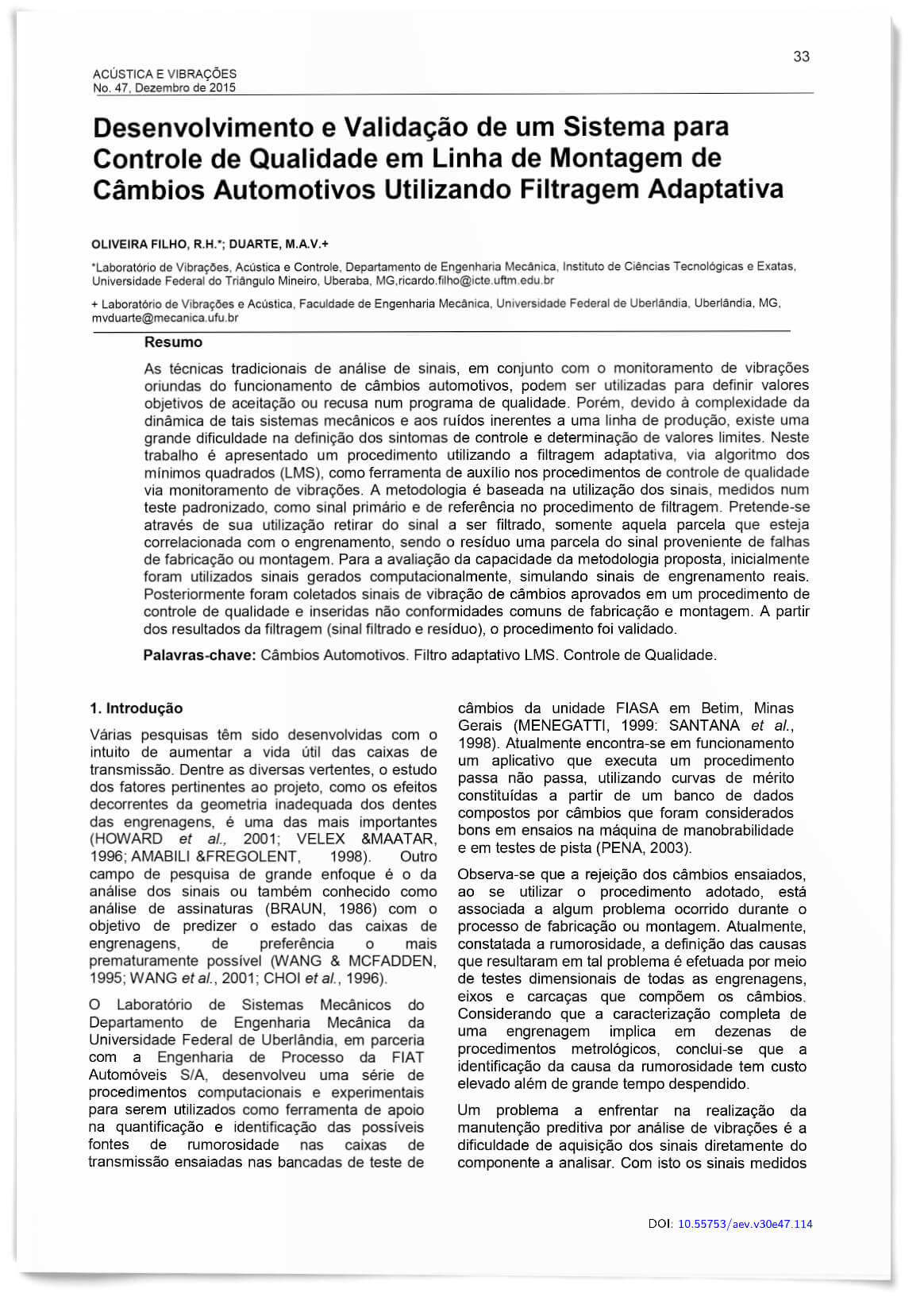Development and Validation of a Quality Control System in Automotive Gearbox Assembly Lines Using Adaptive Filtering
DOI:
https://doi.org/10.55753/aev.v30e47.114Keywords:
automotive gearbox, daptive LMS filter, quality controlAbstract
Traditional signal analysis techniques, together with the monitoring of vibrations arising from the operation of automotive gearboxes, can be used to define objective values for acceptance or rejection in a quality program. However, due to the complexity of the dynamics of such mechanical systems and the noise inherent to a production line, there is great difficulty in defining control symptoms and determining limit values. This work presents a procedure using adaptive filtering, via the least squares algorithm (LMS), as a tool to aid in quality control procedures via vibration monitoring. The methodology is based on the use of signals, measured in a standardized test, as the primary and reference signal in the filtering procedure. It is intended, through its use, to remove from the signal to be filtered, only that portion that is correlated with the mesh, with the residue being a portion of the signal coming from manufacturing or assembly failures. To evaluate the capacity of the proposed methodology, initially computationally generated signals were used, simulating real gearing signals. Subsequently, vibration signals were collected from transmissions approved in a quality control procedure and common manufacturing and assembly non-conformities were inserted. From the filtering results (filtered signal and residue), the procedure was validated.
References
AMABILI M.; FREGOLENT A., 1998, A Method to Identify Model Parameters and Gear Errors by Vibrations of a Spur Gear Pair, Journal of Sound and Vibration, Vol. 214, No. 2, pp. 339-357. doi: 10.1006/jsvi.1998.1587 DOI: https://doi.org/10.1006/jsvi.1998.1587
BEZERRA, R. A., 2004, Detecção de Falhas em Rolamentos por Análise de Vibração. Dissertação de Mestrado, Universidade Estadual de Campinas, Campinas, SP, Brasil.
BRAUN, S., 1986, Mechanical Signature Analysis: Theory and Applications, 1.ed. Academic Press, London, 385p.
CHOI, F. K.; POLYSHCHUK, J. J. Z.; HANDSCUH, R. F.; TOWNSEND, D. P., 1996, Analysis of the Effects of Surface Pitting and Wear on the Vibration of a Gear Transmission System, Tribology International, Vol. 29, n. 1, pp. 77-83. doi: 10.1016/0301-679X(95)00037-5 DOI: https://doi.org/10.1016/0301-679X(95)00037-5
HOWARD, I.; JIA, S.; WANG, J.,2001, The Dynamic Modeling of Spur Gear in Mesh Including Friction and a Crack, Mechanical System and Signal Processing, Vol. 5, pp. 438-449. doi: 10.1006/mssp.2001.1414 DOI: https://doi.org/10.1006/mssp.2001.1414
MARQUES, P. A. C., 2003, Introdução à Filtragem Adaptativa. Instituto Superior de Engenharia de Lisboa, Apostila do curso de Processamento Digital de Sinal II – Engenharia Informática e de Computadores.
MENEGATTI, W. B., 1999, Identificação de Falhas em Caixas de Câmbios, Via Sinais de Vibração, Dissertação de Mestrado, Universidade Federal de Uberlândia, Uberlândia, MG, Brasil.
NUNES, M. A. A., 2006, Uma Metodologia para Quantificação da Contribuição Sonora de Fontes de Ruído Industrial no Meio Ambiente, Dissertação de Mestrado – Universidade Federal de Uberlândia, Uberlândia, MG, Brasil.
PENA, J. L. O., 2003, Um Estudo Sobre o Uso de Técnicas Não Tradicionais Aplicadas à Detecção de Defeitos de Fabricação em Câmbios Automotivos, Tese de Doutorado, Universidade Federal de Uberlândia, Uberlândia, MG, Brasil. doi: 10.14393/ufu.te.2003.7 DOI: https://doi.org/10.14393/ufu.te.2003.7
SANTANA, D.; RIBEIRO, C. R.; DUARTE, M. A. V.; CABACINHA, A., 1998, Um Procedimento Estatístico Para Identificação de Rumorosidades em Câmbios em Linhas de Montagem, Congresso SAE Brasil’98, São Paulo, Brasil.
VELEX, P.; MAATAR, M., 1996, A Mathematical Model for Analyzing the Influence of Shape Deviations and Mounting Errors on Gear Dynamic Behavior, Mechanical Systems and Signal Processing. Vol. 191, No. 5, pp. 629-660. doi: 10.1006/JSVI.1996.0148 DOI: https://doi.org/10.1006/jsvi.1996.0148
WANG, W. J.; MACFADDEN, P. O., 1995, Decomposition of Gear Motion Signals and Its Application to Gearbox Diagnostics, ASME Journal of Vibration and Acoustics, Vol. 117, pp. 363-369. doi: 10.1115/1.2874462 DOI: https://doi.org/10.1115/1.2874462
WANG, W. Q.; ISMAIL, F.; GOLNARAGHI, M. F., 2001, Assessment of Gear Damage Monitoring Techniques Using Vibration Measurements, Mechanical Systems and Signal Processing. Vol. 15, No. 5, pp. 905-922. doi: 10.1006/mssp.2001.1392 DOI: https://doi.org/10.1006/mssp.2001.1392

Published
How to Cite
Issue
Section
License
Copyright (c) 2015 Acústica e Vibrações

This work is licensed under a Creative Commons Attribution-NonCommercial-ShareAlike 4.0 International License.




